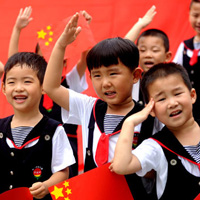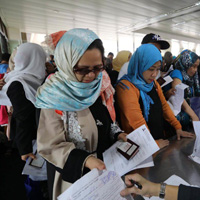-
李彦宏:AI让生活变得更美好
中新网5月28日电 “AI 的使命不是替代人,是让技术忠诚于人类,服务于人类,让人类的生活变得更美好。”在前两天2018中国国际大数据产业博览会(简称数博会)上,百度公司董事长兼首席执行官李彦宏在“为了一个更美好的 AI 时代”主题演讲中如是说到。而在当天现场,李彦宏就让“AI让人类生活变得更美好的使命”落了地,提出搜索 “永远不放广告”的新宣言,并顺势展示了百度新产品——简单搜索。 作为一款AI时代革命性搜索产品,我们发现其不仅可以使用到百度搜索的主要功能,而且交互界面更加简洁、清爽,提供了阅读模式、长屏截图等多项便捷功能。更为重要的是,其还内置了语音识别、自然口语理解、多轮对话、深度问答、图像识别、视频理解等前沿人工智能技术,产品交互上也更倾向于引导用户更多使用语音、图像等新一代搜索方式,可谓是一款名副其实的AI搜索引擎。 本质上,“简单搜索”关注的核心是用户需求场景和人群差异性。在现场演示中,李彦宏展示了“简单搜索”多项功能,其能依靠声纹识别技术,识别成人与少儿,并在识别用户为少儿时,智能开启少儿模式,打造健康纯净、对少年友好的网络环境。同时,借助百度强大的AI技术优势,“简单搜索”将让搜索实现了千人千面,如针对儿童人群的少儿版、针对粉丝人群的明星联名版等,让搜索对不同用户提供不同的产品特性,从而实现了“信息与人”的最优匹配。 让人惊喜的是,“简单搜索”将不再依托传统的广告模式进行盈利,而会基于强账号和熊掌号发掘搜索场景下用户消费内容、延伸到服务的价值,从而实现对百度整体战略布局的优化。而针对用户对产品“既然不会出现广告,为何还出现屏蔽广告功能的疑惑?”,“简单搜索”产品负责人表示:广告屏蔽功能是作为第三方落地页上,特意用来屏蔽影响网页浏览体验的广告,目的是让阅读体验更好。 无广告的“简单搜索”以人工智能为桨,意义绝不仅限于巩固搜索业务,其未来还将进一步打开更大的商业想象空间,并为百度人工智能大战略产生积极作用。通过满足不同人群在丰富场景下的搜索需求,“简单搜索”一方面会积累海量数据,从而优化算法模型;更为核心的是,通过对用户多元消费内容的洞察,简单搜索将对用户需求有更精准的把握,从而实现对百度生态的反哺,提升竞争壁垒。正如腾讯不通过微信直接盈利,简单搜索有望通过建立超级入口地位、构建全新的线上线下交互通路,酝酿生态势能,进而提高商业价值。 随着技术的不断成熟,AI也已从起初的概念衍生、学术研究、技术开发,逐步推进至如今的应用落地阶段。尤其在交通运输、军民融合、智慧城市等各行业的垂直应用陆续浮出水面。 不过,AI黑科技在展示其广阔的应用前景的同时,也给人类命运提出了新挑战。技术应如何发挥力量?什么样的技术是好的技术?李彦宏认为,所有的 AI 新产品、新技术都要有一个大家共同遵循的理念和规则,这样才能实现技术的正面力量,让AI教会人们更好地学习,让人类去发现更多自由和可能。转型AI后,百度提出用 “用科技让复杂的世界更简单“的新使命。起码目前,用技术让复杂的搜索更简单,百度已经做到了。文章选自中新网,2018年5月29日
2018年5月30日 -
马蔚华:什么才是现在投资的潮流?
“影响力投资正在当今世界成为主流价值观,正在成为投资的潮流,这是上善的资本。”4月22日,在“2018中国绿公司年会”的“影响力投资:上善的资本”专场中,中国企业家俱乐部理事长、国际公益学院董事长、原招商银行行长马蔚华表示。 马蔚华进一步解释究竟什么叫影响力投资,从概念说,是追求正面的财务回报,同时要有显著的社会影响力的投资行为。影响力投资是公益金融的一个重要内容,公益金融是商业文明和公益理念的结合。具体说,就是用现代企业的管理办法管理公益组织。用市场的方法分配公益资源,用金融的手段达到公益的目的。 他认为,影响力投资是一个新概念,是即将汹涌澎湃的历史潮流,并呼吁投资界的朋友,认清影响力投资,并加入其中。 文章选自经济网,2018年5月
2018年5月30日 -

【South China Morning Post】What’s the price of a trade war truce?
Exporters in Brazil, Australia and Russia could feel the pinch if China switches suppliers of some of its big-ticket imports to head off a trade war with the United States, according to analysts.That was the assessment after two days of “constructive” high-level talks in Washington last week yielded a commitment from China to “substantially” reduce the trade imbalance between the two countries.As a result, US Treasury Secretary Steven Mnuchin said the US expected American agricultural exports to China to rise by between 35 and 40 per cent this year and energy purchases to double over the next three to five years.That could leave some of China’s trading partners, including its biggest soybean supplier Brazil, beef producer Australia, and even regional semiconductor makers, out in the cold if China shifts orders to the US.“The state-led efforts to increase China’s imports from the US will lead to trade diversion – other economies will see their exports to China fall as a result,” Louis Kuijs, chief Asia economist of Oxford Economics, wrote in a note.Washington wants Beijing to cut the bilateral trade gap by US$200 billion by the end of 2020, or more than half of last year’s US$375 billion difference, based on US figures.Kuijs said that target would be “practically impossible” to meet.One area where Washington is hoping to boost sales is in agriculture.US farm products accounted for about 20 per cent, or US$21 billion, of China’s agricultural imports last year. About two-thirds of this was in soybeans.China buys about 60 per cent of globally traded soybeans and last year about half of its imports came from Brazil, while the US supplied around a third.The US could also eat into Australia’s 90 per cent share of China’s chilled beef imports if Beijing decides to bring down the barriers.But Wang Jun, chief economist of regional Chinese bank Zhongyuan Bank, said this was a zero-sum game.“There is limited room to further increase the purchase of American agricultural products unless it is at the cost of other countries,” Wang said.However, energy supplies offer more scope for growth for the US, given the low base and high demand, according to Bai Jun, executive director of the Institute of International Energy, a body affiliated with the National Development and Reform Commission.China’s energy imports from the US amounted to just US$7.2 billion last year, or 2.9 per cent of the total.Bai said China’s demand for natural gas was so strong that “more imports from the US will not have any impact on other suppliers. These existing supplies ... are simply not enough for the country.”That shortfall was evident last winter when a sudden switch to liquefied natural gas left many homes in northern China without heating, despite a surge in imports from Australia and Central Asia.Nevertheless, the US could also emerge in the longer run as a more stable energy supplier than the Middle East and even Russia, Wang said.To that end, China Petroleum and Chemical Corp has already signed a US$43 billion non-binding deal to explore for natural gas in Alaska, a deal financed in part by China’s sovereign wealth fund, China Investment Corp.Wang said Beijing’s fresh promises to buy more energy from the US were largely political and would inevitably affect other trading partners.Larry Hu and Irene Wu, from Macquarie Capital, said China’s promise of a “meaningful” increase in energy and agricultural purchases could come with a condition that the US loosen its restrictions on hi-tech exports.China has been lobbying Washington to ease restrictions on hi-tech exports to China for years, and a relaxation would divert trade flows of certain products from Asia to the other side of the Pacific, they said.But the statement released at the end of the two days of talks skirted the issue, suggesting tensions linger.“[The joint statement] touched only lightly on China’s technology policy and did not refer to its industrial policy, which is highly controversial in the US ... underscoring that the broader tension is not resolved,” Kuijs wrote.Also untouched were the thorny issues of China’s “Made in China 2025” initiative to support domestic technology and the US chip ban on ZTE, leaving the danger of a trade war lurking, Hu and Wu said.“Trade imbalances could be a strategic weapon used by the US towards China, just like the vote on most favoured nation [status was] in the 1990s,” they wrote, referring to an annual review Washington used to pressure Beijing over other issues such as human rights.At the same time, the truce – or delay – in a trade war between the world’s two biggest economies was in general good for the two countries, and in turn the whole global economy, said Wang Huiyao, director of Centre for China and Globalization(CCG), a think tank based in Beijing.“Avoiding a trade war fits into everybody’s interests,” Wang said. “I don’t think there would be ‘a loser’ [from the China-US agreement].”From South China Morning Post,2018-5-22
2018年5月30日 -

【Bloomberg】China Considers Ending Birth Limits as Soon as This Year
■ Plans to scrap controversial policy after about four decades■ Births fall despite 2015 decision to let parents have two kidsChina is planning to scrap all limits on the number of children a family can have, according to people familiar with the matter, in what would be a historic end to a policy that spurred countless human-rights abuses and left the world’s second-largest economy short of workers.The State Council, China’s cabinet, has commissioned research on the repercussions of ending the country’s roughly four-decade-old policy and intends to enact the change nationwide, said the people, who asked not to be named while discussing government deliberations. The leadership wants to reduce the pace of aging in China’s population and remove a source of international criticism, one of the people said.Proposals under discussion would replace the population-control policy with one called “independent fertility,” allowing people to decide how many children to have, the person said. The decision could be made as soon as the fourth quarter, the second person said, adding that the announcement might also be pushed into 2019."It’s late for China to remove birth limits even within this year but it’s better than never," said Chen Jian, a former division chief at the National Family Planning Commission, who’s now a vice president of the China Society of Economic Reform. "Scrapping birth limits will have little effect on the tendency of China’s declining births."Baby-related stocks climbed in China Tuesday, with Ningbo David Medical Device Co., a maker of infant incubators and obstetric equipment, surging by as much as 10 percent. Childcare firms climbed with toy makers, while infant formula producers Beingmate Baby & Child Food Co. and Bright Dairy & Food Co. jumped at least 1.4 percent.On Monday, Danone, which has doubled its share of China’s baby food market in the past five years, rose to a session high before paring gains, while U.K.-based Reckitt Benckiser Group Plc shares erased declines in London.The policy change would close the book on one of the largest social experiments in human history, which left the world’s most-populous country with a rapidly aging population and 30 million more men than women. The policies have forced generations of Chinese parents to pay fines, submit to abortions or raise children in the shadows.Two-Child PolicyThe U.S. and other Western nations have criticized the coercive measures required to enforce the birth limits, including steep fines, sterilization and forced abortions. The 2015 shift toward a two-child policy was part of a gradual effort to loosen the birth limits over the years as China’s working-age population began to wane.An initial feasibility study was submitted to Chinese Premier Li Keqiang in April, according to one of the people familiar with the discussions. That study found there would be “limited” benefits to lifting birth restrictions nationwide. Li requested more research on the social impact of scrapping the policy altogether, the person said.Neither the State Council Information Office nor the National Health Commission immediately returned faxed requests for comment Monday."The policy shift will hardly boost the number of newborns in China," said Huang Wenzheng, a specially-invited senior researcher of Center for China and Globalization(CCG), a Beijing-based think tank. "China’s number of births will continue to drop dramatically, considering a sharp decrease in the number of fertile women and declining fertility willingness."Still, the move underscores growing concern among Chinese policy makers that more dramatic action is needed three years after allowing all families to have two children instead of one. Births fell 3.5 percent to 17.2 million nationwide last year, according to the Bureau of National Statistics, erasing almost half of the increase in births caused by relaxing the policy.China’s graying society will have broad consequences for the nation and the world, weighing on President Xi Jinping’s effort to develop the economy, driving up pension and healthcare costs, and sending foreign companies further afield for labor. The State Council last year projected that about a quarter of China’s population will be 60 or older by 2030, up from 13 percent in 2010.“The low birth rate and low number of newborns from the previous two years after the two-child policy sent a strong message to the decision-makers that the young generation has a weak willingness to have more children,” Chen said. “China’s population issues will be a major hurdle for President Xi Jinping’s vision of building a modernized country by 2035.”China’s graying society will have broad consequences for the nation and the world, weighing on President Xi Jinping’s effort to develop the economy, driving up pension and healthcare costs, and sending foreign companies further afield for labor. The State Council last year projected that about a quarter of China’s population will be 60 or older by 2030, up from 13 percent in 2010.“The low birth rate and low number of newborns from the previous two years after the two-child policy sent a strong message to the decision-makers that the young generation has a weak willingness to have more children,” Chen said. “China’s population issues will be a major hurdle for President Xi Jinping’s vision of building a modernized country by 2035.”In March, China removed the term “family planning” from the name of the newly consolidated National Health Commission -- the first time since 1981 that no agency bears the name. Xi and Li also omitted any reference to the phrase from key policy reports in recent months.Gender GapWhile China credits birth limits with helping to launch a decades-long economic boom under reformer Deng Xiaoping, they have also exacerbated demographic imbalances, with many parents choosing to abort female fetuses. China has 106 men for every 100 women, compared with 102 globally, according to the CIA World Factbook.Such moves have done little to increase the fertility rate, with many parents concerned about the costs of raising additional children in a society accustomed to focusing family resources on one. Nonetheless, Chinese policy makers have resisted calls by economists and demographers to relinquish control amid concerns over the impact of a sudden increase in births or older parents angry about missing the chance to expand their families.Even a short-lived baby boom could prove lucrative for businesses who cater to childrens’ needs in the world’s most populous county. Chinese consumers bought $19.4 billion of infant products between September 2016 and August 2017, an 11 percent increase, according to an annual report released by Nielsen Holdings Plc in November.From Bloomberg,2018-5-21
2018年5月30日 -

【manilatimes】Huge potential for OFWs in China
BEIJING: President Rodrigo Duterte wasn’t joking when he said that our OFWs may soon look to China as an alternative job market to the “notorious” Middle East destinations preferred by our migrant workers. Senior Chinese officials I recently met with told me that President Xi Jinping was very keen on strengthening the relations between China and the Philippines, particularly on labor matters.It was at the recent Boao Forum in Hainan, China—the Asian counterpart of the World Economic Forum in Davos, Switzerland—that the seeds of labor cooperation were planted. During the forum, President Duterte and President Xi witnessed the signing of a “Memorandum of Understanding on the Employment of Filipino Teachers of English Language in China” by Labor Secretary Silvestre Bello 3rd and Chinese Ambassador to Manila Zhao Jianhua.I was told there is a big requirement for English teachers in China right now, mainly driven by the high demand from its growing and affluent middle class whose children are looking to study or work abroad. Informally, many Filipinos are already teaching English to Chinese nationals via online tutorials. In fact, our English tutors are quite popular in China not only because they are equally good but also because they charge much less (per hour) than American or British instructors.Apparently, English education is China is quite costly. Many Chinese universities have taken to hiring highly paid (i.e. expensive) American and British teachers for their English language courses or classes. Even so, the demand for English teachers outstrips the supply, especially with many Chinese universities now offering four-year bachelor’s degree courses in English such as Business English, English Language, etc.There is also an increasing number of English-taught programs in Chinese universities, ranging from esoteric majors like Fluid Mechanics and Material Sciences to the more elementary courses like English Literature. Eager to meet this burgeoning demand, many Chinese universities are keen on bringing more English-proficient expatriate teachers into their workforce, Filipinos included.The demand from urban Chinese is so huge that a global English language company is expanding to China’s second- and third-tier cities by setting up 40 new learning centers in the next few years. This comes as the frequency of English being spoken during daily work has risen from 70 percent to 90 percent, based on a survey conducted by the company.According to Chinese officials, with the memorandum of understanding (MOU), it will be the first time that teachers from a country whose native tongue isn’t English are going to be allowed to teach English in China. And in order to ease the entry of Filipino teachers, the Chinese government is waiving the requirement that foreign tutors should have at least two years experience in their field of work. If this English teachers program can be implemented successfully, it will pave the way for other types of Filipino workers—nurses, caregivers, domestic helpers, cooks, etc.—to enter the Chinese job market.Given China’s aging population and the lack of workers who can speak fluent English, there is a big opportunity for our OFWs to work in China, with a higher pay and better working conditions than in the Middle East.This is why putting in place a policy framework for Filipinos to legally work in China, starting with Filipino English teachers, is a big step forward. It will not only help stem the influx of illegal migrant workers but also allow our OFWs to enjoy the protection and safeguards accorded to accredited expatriate workers.Although no exact figures were given, I was told there are at least a thousand Filipinos working in China, some of them in the business sector as computer engineers, programmers, interior designers, graphic artists, etc. Of the 13,000 expatriate workers in the Middle Kingdom, Chinese authorities say only 3.8 percent (or around 500) are Filipinos.There are also quite a number of OFWs working illegally as domestic helpers and nannies in China. I’m told most, if not all, of these domestic workers and nannies were OFWs recruited abroad and entered China through third countries like Malaysia and Hong Kong.“In many of Beijing’s high-end residential communities, Filipino maids are frequently seen working illegally. The employment of these workers has become a fact on the mainland,” according to Miao Lu, secretary general of the Beijing-based Center for China and Globalization (CCG) think tank.Longtime Filipino expatriates in China say many wealthy Chinese families desire the same lifestyle as their Hong Kong compatriots who have English-speaking nannies taking care of, and tutoring, their children. And they’re reportedly willing to pay top dollar to get them. In Shanghai, for instance, where expatriates are legally allowed to hire domestics, a Filipino household worker usually earns 7,000 to 8,000 yuan (or P65,000) a month—almost double the HK$4,210 minimum salary for a domestic worker in Hong Kong.The possibility of English-speaking Filipino domestics working in China being paid as much as $1,250 a month, has already triggered some panic among middle-income families in Hong Kong and Singapore, who fear a mass exodus of OFWs from their cities.The MOU on English teachers comes at a very opportune time since China has started to ease the restrictions on expatriate workers. From three work categories – high-end workers, professional staff, and general foreign workers – China will now only have a single category for all expatriate workers, to be governed by the same rules and regulations.Forging and expanding its labor agreement with China augurs well not only for the country but also for many Filipinos seeking to work abroad. Of course, this was only made possible by President Duterte’s independent foreign policy, and his approach to deepening bilateral cooperation on less contentious matters, such as labor and trade.From manilatimes,2018-5-29
2018年5月30日 -

【人民日报海外版】中国创新成果加速惠及世界
“墨子号”量子卫星与阿里量子隐形传态实验平台建立天地链路。新华社记者 金立旺摄 近日,“华龙一号”核电项目一机组穹顶吊装。这成为海外社交平台上的热门话题,有人直呼“太神奇了”。 参观国产大飞机C919整装车间时,俄罗斯记者说的最多的两句话是:“我的天啊”;“快看这儿”。 越来越多的中国创新成果让世界赞叹。 两年前的2016年5月30日,习近平总书记在“科技三会”(全国科技创新大会、两院院士大会、中国科协第九次全国代表大会)上强调,“综合判断,我国已经成为具有重要影响力的科技大国。” 两年后的2018年5月28日,两院院士大会召开。两年来,中国科技创新水平加速迈向国际第一方阵,同时也加速影响世界、惠及世界。在蒙内铁路蒙巴萨西站,一名肯尼亚记者和火车司机合影。新华社记者 孙瑞博摄频获赞叹 这几天,一则来自中国的消息,在海外社交媒体上被广泛转发和评论。 5月23日,中国自主研制的三代核电技术“华龙一号”防城港核电3号机组,进行了穹顶吊装。更重要的是,防城港“华龙一号”核电项目是未来将在英国建设的“华龙一号”项目的参考电站。 中国核电技术出口英国,这是不少外国人没有想到的。布莱恩·尼古拉斯是美国核工业部门的高级操作员,他在推特上评论说:“中国能走到这一步,真的很神奇。” 事实上,中国的核电技术不仅将走进英国。据统计,中国已与阿根廷、肯尼亚、巴西等近20个国家达成了合作意向。 中国科技进步的速度,让很多外国人大吃一惊。 从2017年5月首飞,到如今在海内外获得超过800架的订单数,国产大飞机C919的这一年让世界惊叹。 在位于上海的C919生产基地,今日俄罗斯电视台国际频道记者艾米丽·萧说的最多的两句话就是:“我的天啊”;“快看这儿”。 C919不仅有38.9米的机身长度和35.8米的翼展,更有反推装置设计、主动控制技术等102项关键技术突破。 在量子通信方面,中国已经领跑世界。2017年6月,中国科学家在美国《科学》杂志上报告说,中国在世界上首次实现千公里量级的量子纠缠。 对于这一消息,加拿大卡尔加里大学物理学家沃夫冈·迪塔尔表示,“我被中国团队的结果震惊了,我个人之前看到量子卫星发射后,并不确定能获得什么结果,也不确定他们是否能用它实现技术突破。” 5月26日,中国量子通信传来最新消息。在2018中国国际大数据产业博览会开幕式上,中国科学院院士潘建伟表示,目前已实现北京和奥地利维也纳之间的洲际量子通信实验。 近年来,C919创造新的“中国高度”;“复兴号”疾驰出“中国速度”;北斗卫星导航系统展示“中国精度”;“海燕”、“潜龙”、“深海勇士”成就“中国深度”……中国一系列创新成果让世界震撼。 德国经济新闻网刊文称,“中国政府正在大力鼓励创新,数字产业的下一个世界领导者将来自中国。” 世界银行前经济学家、肯尼亚学者姆旺吉·瓦吉拉表示,“近年来,中国在科技领域不断取得令世人震惊的成就,正在成为掌握诸多前沿科技的全球引领者。”造福海外 “泰国总下雨,能不能搞一个下雨天也能拍照的卫星?”2005年,泰国公主诗琳通的这一问,让她与中科院院士李德仁成了朋友。 当时,李德仁肯定地说:“可以呀,搞个雷达卫星就能穿透云层了。” 诗琳通喜出望外,旋即安排泰国科技部部长访华,主抓中泰北斗合作。 如今,中国的北斗导航系统已经进入泰国,在泰国的智慧交通、海洋渔业等领域发挥作用。 按照北斗导航发展规划,到2020年,中国将建成世界一流的北斗全球系统,为全球提供服务。 李德仁向本报表示,“中国要一步一个脚印地去创新、追赶、超越,争取将更多的核心技术掌握在自己手中。” 中国的科技重器,正凭借着核心技术加速“出海”。 现在,乘坐蒙内铁路(肯尼亚蒙巴萨—内罗毕),下午2∶30从肯尼亚首都内罗毕出发,晚上7∶20就能到480公里之外的蒙巴萨。 当地很多人清晰地记得一年前的5月31日。肯尼亚总统肯雅塔着一身红衣,置身于蒙巴萨站台沸腾的人群中,亲自挥舞起巨大的国旗,送走了在蒙内铁路上奔驰的第一列货运列车。当天,肯雅塔总统激动得在推特上连发了十一条消息,以记录这一重大的历史时刻。中国团队用两年半的时间,圆了肯尼亚人民一个世纪以来的铁路梦。 蒙内铁路是中国首次将国内的全套铁路标准出口到海外。目前,中国已经形成了具有完全自主知识产权和世界先进水平的高铁技术体系,凭借这些技术,中国高铁已经销往全球100多个国家和地区。 新一代信息技术也在加快升级,成为中国连接世界的纽带。 在位于马来西亚吉隆坡机场的国际超级物流枢纽eHub内,搬运机器人在智能算法的指引下精准地运送货架。虽然通行空间狭窄,但它们照样快速移动,不会相撞。这批机器人的工作效率比人工效率提高了3倍。 马来西亚超级物流枢纽是中国在境外打造的首个超级物流枢纽。在这里,菜鸟物流建立起东南亚首个智能仓库,开启了科技驱动的新物流时代。 中国云计算技术也加速走出国门。4月23日,腾讯云泰国数据中心正式对外开放服务,面向泰国本地及周边区域就近提供云计算、大数据及人工智能产品和技术。同月,阿里云进入土耳其市场,为当地提供弹性计算、数据库服务以及大数据等一系列产品。 巴基斯坦独立新闻社中国业务总监贾韦德·阿赫塔尔表示,中国加快建设创新型国家、推动重大科技创新取得新进展,对发展中国家具有重要借鉴意义。中国科技创新也将有助于推动全球科技进步,造福各国人民。 《华尔街日报》刊文称,中国正努力重现历史辉煌,在科技创新上“重回世界之巅”。汇聚人才 在清华园生物信息学教育部重点实验室,试管、玻璃杯、显微镜等仪器设备有序地排列在试验架上。查克戴上蓝手套和口罩,从药品阴凉柜里拿出材料,开始一天的研究。 查克是一名美国生物学博士,现在在清华大学医学院当助理教授。他是被中国创新的“沃土”吸引过来的。 “清华大学拥有的冷冻电镜和显微镜的数量是世界其他机构不能比的。”查克说,中国科技水平世界认可度越来越高。 查克不是个例。中国与全球化智库创始人王辉耀分析说,中国现在参与“全球人才环流”,外国人到中国发展,这在未来10年、20年会成为一个新趋势。 全国各地的数据印证了这一趋势。以四川成都为例。成都高新区于去年7月出台人才新政,截至目前,已柔性吸引邵斯达克、夏普莱斯、约翰·戈登、毕晓普、罗伯特·胡贝尔、罗杰·科恩伯格6位诺贝尔奖获得者开展前沿技术交流及科技项目合作。 对于海外人才来华,中国官方态度很积极。2017年底出台的《科技部关于推进外籍科学家深入参与国家科技计划的指导意见》明确提出,鼓励外籍科学家领衔和参与国家科技计划项目研究。除涉及国家安全等特殊情况外,鼓励外籍科学家依托在我国大陆境内注册的内、外资独立法人机构,领衔和参与申报国家科技计划项目,通过公平竞争承担研发任务。 在海外人才来华的同时,中国留学生也更多地选择回国。据美国媒体报道,在硅谷的中国技术人员群体正悄然掀起了一场回国潮。越来越多的中国留美人才放弃外企工作和美国绿卡,选择回国工作、创业。 对于这一现象,美国作家约翰·奈斯比特和多萝西·奈斯比特在新书《中国大趋势》一书中写道,中国政府正在“构筑森林,让树木(人民)成长”,因为中国政府创造了一个“让人们开创事业、实现个人梦想的环境”。他们表示:“我们见证了中国政府关于高科技园区和创新集群的战略规划的实施。” “越来越多的人才选择了回国,原因是中国已真正获得了创新时代的动能。”供职于美国知名猎头公司史宾沙的肯齐表示,“目前仅仅只是开始。”文章选自《人民日报海外版》,2018年5月29日
2018年5月30日 -
崔大伟:留学与海归背后的制度变迁
崔大伟,CCG国际顾问委员会顾问、香港科技大学中国跨国关系中心主任 今天的世界是知识经济的世界,各国都在竞争技术人才。很多国家都制定了战略性的人才政策以吸引国际人才定居。但是吸引人才的重要性和政策不受欢迎是个两难问题,这时就凸显了政策制定者的重要作用。 中国政府在逐步开放留学,积累人才储备,进而引进海归学者、科学家和企业家的过程中扮演了至关重要的角色。他们努力提出创造性的政策,试着解决许多阻碍顶尖人才回国的一系列因素,包括官僚抵抗,制度性歧视,保守主义带来的政治经济危机,以及有缺乏稳定的终身教职等一系列问题,并带来令人瞩目的成就。 那些希望吸引海归劳动力的国家首先需要在科学基础设施上积极投资,提供等同于甚至优于发达国家的实验室和设备。Savaria和Miranda认为,当科技政策和科学投入相匹配、真正的机会出现的时候,早年去海外的淘金者自然会回国。然而,更重要的是一个国家的“软环境”,诸如法律、文化和人际关系。Newland则认为,往返于家乡和移民国家的人回国,最根本的因素是法制,产权保护,公开、透明以及清廉的政府和一系列善治的措施,包括双重国籍或者绿卡等。 其次,吸引海归的另一个关键是东道国和收入差距。税收减免、居住津贴、高薪水、便宜的贷款和经费的自由处分权都会吸引海外人才回来。然而,这些优惠政策都不免带来本地学者的敌意,不少人会把海归看成是一种威胁。同时海归还会引起区域发展不平等。 再者,人的回流会可以改变权力的分配、想法和资源。即使海外人才不愿意回国,他们仍然可以通过侨民的身份为祖国发展做贡献。国家也希望能够借助他们的跨国资本。因此侨民们可以通过赫希曼所说的“退出”:也就是拒绝回国,或者是通过请愿和集体发声、抗议或者是海外的游说,来迫使当权者改变政策以吸引人员回国。 在改革的过程中,中国的领导者们试着积极回应这些问题。他们提供了经济补偿和特殊政策,把人才放在国家发展的第一位,加大科研项目投资力度,同时承诺人才自由流动,鼓励人们出国并认可他们在国外所学的知识。目前,国家重点项目学科带头人中,超过七成是海归。这些成就并非一日之功,而是通过许多代领导人的长期努力,让中国得以离开计划经济,闭关锁国的状态,在世界范围内储备人才,进一步成为人才回流的中心。然而,政策开放的过程遇到的艰辛和阻力也非同一般,于是在早期呈现出一种新领导上任,政策“放-乱-抓-死”的螺旋上升的路径。这个过程对其他发展中国家也有非常重要的借鉴意义。【1978-1998】游离于开放与收紧 改革开放之初,邓小平就对中国和世界的科研水平差距忧心忡忡。于是在1978年6月教育部组建了一次特别小组,研究管理留学事务。在会议上,邓小平批评当时的海外留学政策“太死板”,认为“独立和自力更生并不意味着闭门造车”。这次会议是留学事业的破冰之举。最初邓小平的想法是每年出去一万人,但教育部最终把名额定在三千人每年,部分是由于资金的分配问题。在1980年之前,所有留学生都必须得到教育部或是中科院的批准和资助。 1980年教育部试着开放了自费留学,然而紧接的一波高干子弟的自费留学潮导致项目被迫取消。 1984年春天,中国进一步开放了留学的大门。新的政策允许中国的大学和海外高校建立交换生,学生们可以直接申请海外奖学金。因此自1984年11月起,任何拿到海外奖学金的学生都可以出国留学。自费的学生想要出国只需公安局的批准,而不再需要通过教育部。教育改革进展迅速,到了1985年春,海外交换生,教材和学生的入学等方面都进行了一定程度的开放。中国国家科学基金也开始接受海外回国人员的项目申请。紧接着,留学生的配偶被允许出国陪读,导致回国人员的比例迅速下降。许多留学生获得海外的研究生学位后,在海外打工的配偶的支持下继续攻读博士学位。 教育部1987年的调查数据显示绝大多数1983年之后出国的博士生仍然滞留海外。时任国家教育委员会(等同于今天的教育部)副主席的何东昌因而宣布削减留学生的名额,增加短期访学学者,同时禁止了留学人员配偶的出国探视。政府资助的学生如果没有在五年内完成学业并回国,他们的家庭将遭到罚款。政策遭到中国在外留学生的抗议,国外基金会们和大学开始向中国学生提供奖学金,大部分学生不再依靠政府资助,因此这些条款很少得到实施。 上世纪80年代末,中央收紧了价值观和意识形态的控制,然而出国留学的人数大幅上扬。参加托福考试的人数从1989年的36,000人上升到60,000人。同时,受政府资助的留学生普遍滞留海外不归。因此政府进一步加强了对留学的管控,要求留学生出国前必须有不少于五年工作经验。同时留学审批被下放到省教育委员会,自费留学生的人数在1990年比前一年下降了13%。 留学生滞留海外的情况阻碍了邓小平通过海归以现代化中国的构想。1992年8月,政府下达文件允许签证过期的海外留学生可以在使馆续签签证,因公护照也可以转为私人护照。 突然之间,春暖花开。国内人才市场松绑了,海归们也不再必须回到原来的单位。公安部宣布公派留学生的家属们又可以出国了,这也意味着,资助留学人员的工作单位不能通过卡出国审批来讨要经济补偿。同年,人事部首次提出了一项促进海归回流的政策:在深圳、上海和福建设立工作介绍所,提供生活优待,比如更大的房子,高级职称,帮助家庭成员搬迁,提供研究经费,以及成立了一个国家级的海归联谊会。在1993年的十四届三中全会上确立的“支持留学、鼓励回国、来去自由”的十二字主旨,至今都是留学海归政策的指导思想。【1998-2012】伴随着争议的人才国际化 时任中共中央总书记的江泽民也意识到中国的人才属于全球人才储备的一部分,中国的科技管理人才需要到海外去增加人力资本。因此中国必须促进人才国际化。1998年5月江泽民发表了“北大讲话”,倡导建立属于中国的世界一流大学。政府同时设立了985计划以帮助实现这一目标。响应中央的号召,中国科学院扩大了百人计划的规模,从每年的20人扩大到每年100人左右。每个合格人员将获得高达200万元人民币的研究经费。教育部和香港地产大亨李嘉诚一同发起了长江学者计划,给予回国人员可观的收入补助。朱镕基在2001年的全国外资工作会议上进一步补充,“(中国)应当把外资工作的重点….转移到引进先进技术、引进现代化管理、引进专门人才方面来”。 同时,为了让海外华人研究者同时参与到国家建设中来,中央在1997年提出了“为国服务”的概念,与传统的“回国服务”不同,为国服务认可留在海外的公费留学生的贡献,即使他们不愿意“回国”。同时,政府为海外人员提供一系列便利,譬如允许同时保留海外和国内的职务,参与国内外合作项目,回国教书以及技术交流,在中国建立自己的企业等。 到了2000年前后,中央政府进一步提高了人才工作在政府工作计划中的地位。2002年2月,中共中央和国务院一同颁布了《2002-2005年全国人才队伍建设规划纲要》以推动“人才强国战略”。核心原则是对海归“完全的信任”,给予部分顶尖海归人才以领导地位。2002年底,作为分管人事和组织工作的政治局常委曾庆红提出党要进行人才管理,第二年建立的“中央人才工作协调小组”以协调超过20个部委和委员会的工作。 然而,随着海归数量的增加,吸引回国人员的另一个阻力慢慢显现出来。2007年的数据显示,2002年在美获得博士学位的中国大陆留学生高达92%仍然留在美国。相比之下印度的这个比例是81%,加拿大是55%,中国台湾和韩国分别为43%和41%,2007年当年毕业的留学生高达九成都希望留在美国发展。究其原因,研究机构内部的学术环境开放进度的缓慢是最大的障碍。 2004年对3000余名海归的调查显示,最大的阻碍是“人际关系太复杂”,包含了官僚干预、隐性的关系网以及传统文化对海归的种种限制。2007年的另一个调查发现,当海归考量回国与否的时候,他们更希望看到一个全面改善的人才环境,而不是特殊优待。 2007年秋,人才工作经验丰富的李源潮就任组织部长,同时也接手了中央人才工作协调小组。在江苏任省委书记时李源潮曾制定了无锡530计划,为海归创业企业提供高达百分之五十的启动资金资助。来到北京之后,他瞄准了海外最顶尖的华人研究者,想要在人才引流上有大的突破。人才政策核心变为通过改善研究环境,打造一个“宽松、宽容、宽厚”的环境来吸引人才回国。在2009年,他动员各大城市打造各自的千人计划,每个城市都需要制定经济转型计划,以及帮助转型所需要的高端海归的数量,然后去海外招聘人才。然而这个计划遇到了很大的问题。由于最顶尖的华人在海外都拥有极其优渥的待遇和职位,超过三分之二的千人计划都选择不愿意放弃海外的教职。结果千人计划不得不推出短期项目,只要求每年两到三个月在中国任教。另一方面,为了兑现承诺,很多地方政府推选已经回国的人员参加人才计划。2011年为止,有大约50%的获奖人员都属于这种情况。 而研究环境的问题仍然没有很好解决。2011年中组部对千人计划成员的调查显示49%的人抱怨“研究风气不好,把很多的时间花在学术之外的“公关活动上”,另有45.9%的人认为“科研项目审批不透明,存在拉关系、走后门现象”。研究机构对千人计划的态度是矛盾的,有部分机构领导并不欢迎人才计划。在2012年六月组织部召集的一次会议上,北方一所985高校的校长对人才项目的高工资和奖金颇有微词。他认为给于海归过高的待遇是不公平的,会伤害到国内毕业的博士生和研究人员。该提议获得了中科院一个研究所所长的响应。他们都希望平等和无差别地对待研究人员,通过研究机构分配经费而不是通过竞争获取国家自然科学基金的经费。李源潮因而强调人才政策是为了促进“发展”而不是“平等”。 这个会议让我们得以一窥研究机构对新政策的抗拒的一个来源:大学校长和研究所所长们。1999年时,中国最顶尖的38所大学只有不到四分之一的校长拥有海外的博士学位,另外大约四成的校长曾经在海外做过访问学者。而2005年一半的校长都拥有海外博士学位。 相比之下,科学院的国际化程度就不那么尽如人意。拥有海外学位的研究所主任的比例在2013年仅仅上升到26.8%(2002年为18.9%),还有超过四分之一(2002年为39.2%)没有任何海外学习研究经历。为了进一步研究中国研究机构的领导们谁更愿意吸引海归,我们收集了27所985高校1999年到2012年间每年引进的长江学者和千人计划学者的数量,以及校长信息进行量化分析。 结果发现,决定引进海归数量的校长有三个主要因素,校长是否是外部调任,校长是否有在海外的博士学位,以及校长是否还有进一步晋升的机会。我们发现,具有海外长期学习经历的校长可能更看重海归高端人才的价值,而具有晋升潜力的校长在执行中央政策方面也更加积极,所以这两类人群也许有更强的意愿对学校进行一定程度的改革。另一方面,从外部调任来的校长对于学校改革有更小的心理负担,更愿意改变学术环境。 在过去的二十年里,大学的改革者们进行了一系列广泛的人才管理创新,获得了一定的成功。管理模式主要分为三种:一,建立聘任双轨制,允许海归人才选择非编制内,拥有高工资和更大的发表论文压力的职业轨道;二,学校也可以建立具有更大自主权的学术特区,挂靠特区里的海归人员享有对经费更大的处置权。三,学校还可以聘任在海外保留职务的教授担任学院院长,结合学术特区对学校进行小范围改革。改善后的学术环境对海外人才有更大的吸引力。【2012–2018】展望未来 十八大以来,海归和留学政策进行了数次改革。一方面,中央进一步强调爱国主义在人才引进上的重要性,中央同时鼓励留学生到海外展示中国成就,增强中国软实力。另一方面,中央注重如何管理,用好已经回国的人员。在2013年的讲话中,习近平总书记在原有的“支持留学、鼓励回国、来去自由”十二字原则后又增加了“发挥作用”四个字。响应这一号召,地方政府纷纷成立海归人员协会,集中领导处于学校、私企等不同机构中的回国人员,并通过协会加强海归人员和党的联系。政府对移民管理的制度变得更加完善。2015年,中央深化改革领导小组提出需要一个更加合理而实用的境外人士管理办法,于是今年3月在公安部底下组建了副部级的国家移民管理局,负责协调拟定移民政策并组织实施。未来的成功与否还有待时间检验。结 论 纵观过去40年,留学和海归的潮流经历了巨大的变化。从1970年代国门紧锁到近十年的海归潮,开放趋势和旧制度之间的张力推动着每一轮政策的开放和紧缩。在1980年代早期,邓小平要打开留学大门以建设一个强大的现代化的中国,留学生们出于使命感而回国。到了1980年代中期,随着自费留学的扩大,年轻的一代人开始把职业考量看的更重,落后的科技投入是最主要障碍。随着经济发展,到了1990年代后期研究环境、文化因素成为阻碍人才回流的桎梏。尽管政府投入了很大的资金和努力仍然没有办法解决研究环境的问题以吸引最顶尖的人才。幸运的是,在政治动员下,一些学校开展了小范围的创新政策以吸引人员回归。通过人才竞争和鳗鱼效应,许多研究机构研究环境有了一定的改善,然而研究环境的问题仍然是当前阻碍人才回归的最大因素。2013年习近平总书记提出了“支持留学、鼓励回国、来去自由、发挥作用”的方针,进一步确定了鼓励人才流动的指导方针.我们可以期待一个越发壮大的海归群体、更加自由的人才流动的未来。文章选自澎湃新闻,2018年5月25日
2018年5月30日